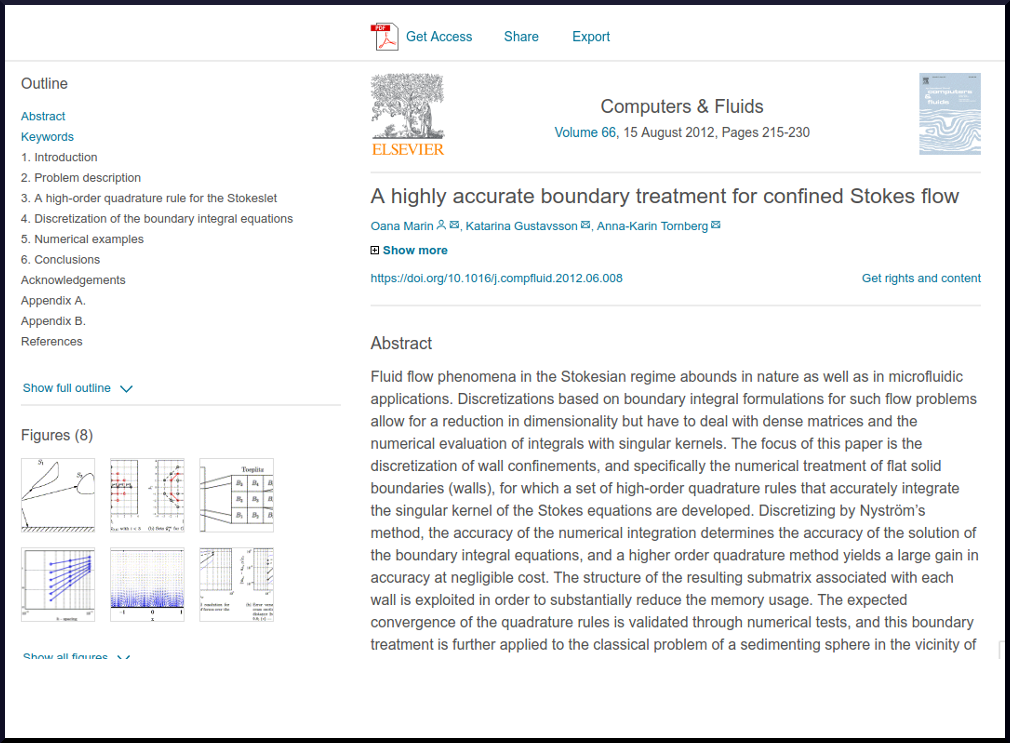


Computers and Fluids
2012, August
Fluid flow phenomena in the Stokesian regime abounds in nature as well as in microfluidic applications. Discretizations based on boundary integral formulations for such flow problems allow for a reduction in dimensionality but have to deal with dense matrices and the numerical evaluation of integrals with singular kernels. The focus of this paper is the discretization of wall confinements, and specifically the numerical treatment of flat solid boundaries (walls), for which a set of high-order quadrature rules that accurately integrate the singular kernel of the Stokes equations are developed. Discretizing by Nyström’s method, the accuracy of the numerical integration determines the accuracy of the solution of the boundary integral equations, and a higher order quadrature method yields a large gain in accuracy at negligible cost. The structure of the resulting submatrix associated with each wall is exploited in order to substantially reduce the memory usage. The expected convergence of the quadrature rules is validated through numerical tests, and this boundary treatment is further applied to the classical problem of a sedimenting sphere in the vicinity of solid walls.
The present contribution addresses numerical aspects encountered in the simulation of confined Stokes flow. The physical problems considered here are formulated mathematically in the framework of boundary integral equations and discretized using Nyström’s method. Specifically, flat bounding walls with periodic boundary conditions in the wall-parallel directions have been considered, and we have extended the work by [25] to obtain analytic expressions for the terms in the rapidly converging sums that define the periodic Stokeslet. The novel element of the present work is the development of an efficient, high-order numerical treatment of a flat surface by designing quadrature rules that can accurately integrate the singular kernel of the Stokes equations using a uniform distribution of quadrature points. This is accomplished by localized corrections to the trapezoidal rule. Even though the correction weights tabulated in this paper are specific to the wall geometry as well as to the singularity given by the free-space Stokeslet, this work defines a framework for designing quadrature rules also for other geometries and/or singularities. Discretization by Nyström’s method combined with these quadrature rules yields a submatrix associated with each wall which is block Toeplitz symmetric with circulant sub-blocks. The symmetry properties of such a matrix can be exploited for memory efficient implementations; specifically we show that the matrix can be generated by only three of its columns. Given a discretization of the wall with a fixed resolution, the accuracy can be increased by applying a higher order quadrature rule, which only requires modifications to the quadrature rule in discretization points in a close neighborhood of the singularity. The accuracy of the quadrature rules has been tested, and the expected orders of convergence (up to 13th order) were obtained. As a discrete system is solved for the force densities at the wall the solution exhibits the same accuracy. This is shown in numerical tests by imposing non-homogeneous boundary conditions at the wall surface. The large gain in accuracy that is obtained as a higher order quadrature rule is used comes almost for free since the resolution of the wall and hence the number of unknowns is fixed. The wall discretization as coupled to an immersed object has been assessed by studying the classical problem of a sphere sedimenting onto a flat plate, for which analytical solutions are known in the case of an infinite wall. Good agreement between our data and the analytic solution is found as the size of the periodic domain is increased. Similar results were found for the case of a sphere sedimenting between two parallel walls. It is found that the high-order treatment of the walls allows for a rather coarse wall discretization. The new quadrature rules are attractive for high-order singularity treatment due to their extremely low cost. A natural and very useful continuation of the work presented here is to extend the numerical treatment of a flat plate to that of other geometries such as pipes, spheres or other curvilinear surfaces. Another track to follow is to design quadrature rules for other fundamental solutions of Stokes flow, such as the Stresslet, that appears in so-called double-layer formulations. As larger problems including many drops or particles in a wall-bounded flow are introduced, a fast summation method will be needed to accelerate the computations that currently scale quadratically with the number of discretization points. The quadrature methods developed here are very well suited to be used in conjunction with fast summation methods, due to their highly localized singularity corrections.